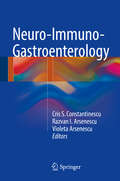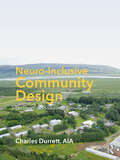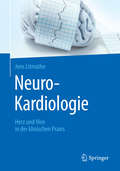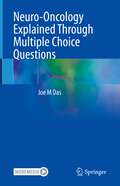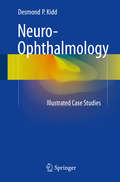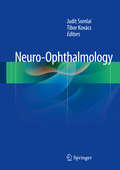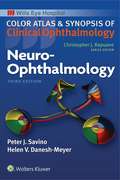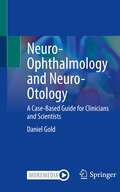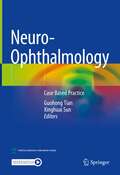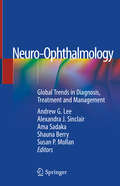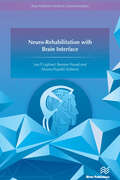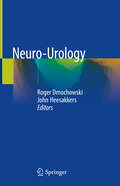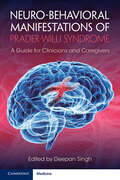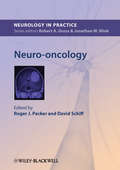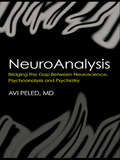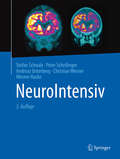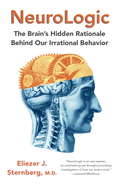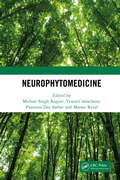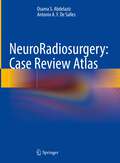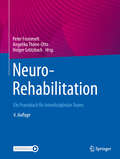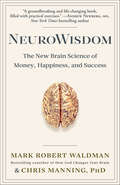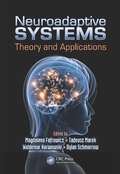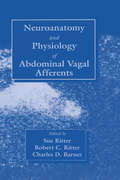- Table View
- List View
Neuro-Immuno-Gastroenterology
by Cris Constantinescu Razvan Arsenescu Violeta ArsenescuThis book addresses importantissues regarding the interaction between the nervous system, the immune system,and the digestive system. Gut flora has a profound influence on the shaping ofthe immune response, not only in the gastrointestinal system but also in thenervous system. Fascinatingly, manipulation of intestinal immune responses canbe used to modulate neurological disease. Conversely, the nervous system andthe psyche have significant effects on the functioning of the gut and liver. After introductory chapters on theneurology, the immunology and microbiology of the gut, the effects of the gutimmune system and gut flora and its manipulation on neurological disease arediscussed, followed by molecular mimicry and immune tolerance in neuroimmunediseases. Additionally, several chapters deal with gastrointestinal manifestationsof neurological diseases. Neuro-Immuno-Gastroenterology is aimed at neurologists, gastroenterologists, andimmunologists.
Neuro-Inclusive Community Design: Lessons from Sólheimar Ecovillage
by Charles DurrettThis book is an inspiring exploration of Sólheimar Ecovillage in Iceland, a pioneering community that embodies sustainability, social responsibility, and inclusivity.Cohousing expert Charles Durrett delves into the unique aspects of this ecovillage of about 100 residents, 45 of whom include those with developmental and intellectual disabilities, who live and thrive alongside neighbors in a safe and enriching environment. Through rich storytelling and detailed first-person accounts, the book highlights the importance of creating communities that celebrate and support neurodiversity. Durrett presents Sólheimar as a model for how we can build neuro-inclusive spaces that respect and uplift every individual’s potential, fostering a sense of belonging and purpose. The book offers practical insights into the design, the principles, and the practices that make Sólheimar a standout community for inclusive living. It challenges readers to rethink conventional approaches, advocating for environments where all people, regardless of their cognitive differences, can live meaningful and fulfilling lives. Durrett also presents case studies of four other neuro-inclusive communities, including Hertha Levefallesskab, WeBUILT (We Build Unique Independent Lives Together), Creative Living Community of CT, and L’Arche International Movement. With its focus on real-world solutions and its call to action, this book is both a guide and an inspiration for anyone interested in the intersection of sustainability, community living, and neuro-inclusivity.It will have a broad audience of architects, designers, occupational therapists, mental health professionals, housing developers, and practitioners in housing and social care, among others.
Neuro-Kardiologie: Herz und Hirn in der klinischen Praxis
by Jens LitmatheDas interdisziplinäre Buch wendet sich an alle Neurologen und Kardiologen sowie Allgemein-Internisten, die mit den Berührungspunkten zwischen Kardiologie und Neurologie konfrontiert sind. 30-40% der Schlaganfälle haben eine kardiogene Ursache. Liegt diese zum Beispiel in einem erstmalig entdeckten Vorhofflimmern, stellt sich Frage, was bei dessen Behandlung zu beachten ist. Welche weitere kardiologische Diagnostik benötigt der Patient und welche Antikoagulation? Diese und andere Fragen zu den vielfältigen Schnittpunkten zwischen Kardiologie und Neurologie beantwortet dieses Buch. Es schärft das Verständnis sowohl für kardiologische Aspekte neurologischer Erkrankungen als auch für neurologische Komorbiditäten kardiologischer Syndrome.
Neuro-Oncology Explained Through Multiple Choice Questions
by Joe M DasThis book provides a detailed overview of the latest developments in the rapidly evolving specialty of Neuro-Oncology arranged in approximately 500 questions arranged in multiple-choice and matching formats. It features insight into the latest World Health Organization classification of central nervous system tumors and molecular genetics with information on how to apply a range of intraoperative adjuncts. Guidance on the latest therapeutic techniques such as stem-cell and immunotherapy in clinical practice is also discussed. To assist the reader in developing a deep understanding of the topics, the questions in all chapters are accompanied by relevant explanations to reinforce the key points covered.Neuro-Oncology Explained Through Multiple Choice Questions is a practical and up-to-date resource on how to diagnose, treat and manage a variety of disorders related to neuro-oncology. Its clear, easy-to-follow format and recognition of critical concepts make it an important resource for neurosurgical and oncology trainees preparing for certification examinations and the more experienced practitioners seeking an overview of the latest developments within the field.Additional questions via app: Download the Springer Nature Flashcards app for free and use exclusive additional material to test your knowledge.
Neuro-Ophthalmology
by Desmond P. KiddThis book presents fifty clinical cases in neuro-ophthalmology, some of which are common and some of which are rare. Each case is presented as a diagnostic and management challenge as found in clinical practice. High quality clinical photographs and images bring the cases to life alongside the diagnostic process and management decisions of an experienced specialist. A short summary of important aspects of the pathogenesis and treatment of each disease finishes each case. Neuro-Ophthalmology: Illustrated Case Studies entertains and instructs the reader and is ideal reading for doctors in training in this area, as well as general consultant neurologists and ophthalmologists.
Neuro-Ophthalmology
by Judit Somlai Tibor KovácsThis practical guide provides an algorithm for diagnosis and treatment, from 'having some problem with vision', via diagnosis of cause and background, to treatment and eventually to rehabilitation. Following on from introductory sections devoted to the role of neuro-ophthalmology, recent developments in the field, and an overview of neuro-ophthalmological examinations, there are sections devoted to the different parts of the visual system, and finally a section on rehabilitation. Neuro-ophthalmology is aimed at ophthalmologists, neurologists, neurosurgeons, traumatologists, neuroradiologists, experts in cardiology and stroke, and trainees in these areas. It will also be of interest to neuro-rehabilitation specialists, neuropsychologists, and those working in typhlopedagogy and health informatics.
Neuro-Ophthalmology (Color Atlas and Synopsis of Clinical Ophthalmology)
by Savino Helen Danesh-MeyerPublisher's Note: Products purchased from 3rd Party sellers are not guaranteed by the Publisher for quality, authenticity, or access to any online entitlements included with the product. Developed at Philadelphia’s world-renowned Wills Eye Hospital, the Color Atlas and Synopsis of Clinical Ophthalmology series covers the most clinically relevant aspects of ophthalmology in a highly visual, easy-to-use format. Vibrant, full-color photos and a consistent outline structure present a succinct, high-yield approach to the seven topics covered by this popular series: Cornea, Retina, Glaucoma, Oculoplastics, Neuro-Ophthalmology, Pediatrics, and Uveitis. This in-depth, focused approach makes each volume an excellent companion to the larger Wills Eye Manual as well as a practical stand-alone reference for students, residents, and practitioners in every area of ophthalmology.
Neuro-Ophthalmology and Neuro-Otology: A Case-Based Guide for Clinicians and Scientists
by Daniel GoldThis book combines the complexities of neuro-ophthalmologic and neuro-otologic disorders into one concise guidebook. It focuses on the basics of these two challenging subspecialties, encountered by the neurologist, ophthalmologist, otolaryngologist, neurosurgeon, emergency medicine provider, and others. Comprehensive and succinct, the book contains chapters examining representative case vignettes that highlight typical historical elements and exam findings that aid in diagnosing a specific disease, disorder, or syndrome. Before each heading, chapters offer a brief review of relevant anatomy, physiology, and examination techniques. Additionally, symptom-based tables guide the practitioner to a focused history and examination for rapid real-time triage and diagnosis. Practical and case-based, Neuro-Ophthalmology and Neuro-Otology is an invaluable resource for practitioners, trainees, and residents in various fields.
Neuro-Ophthalmology: Case Based Practice
by Xinghuai Sun Guohong TianThis book provides a practical guide in neuro-ophthalmology. It contains more than 80 carefully selected neuro-ophthalmic cases. It covers visual afferent (Part 1) and efferent disorders (Part 2): the various optic neuropathies, diplopia from ocular and neurologic pathogen, pupil and lid abnormality. Each case presents with neuro-ophthalmology examination format, followed by ancillary test, finial diagnose, treatment and prognosis. A short review or comment highlights the important points of these disorders, up to date progress and literature are addressed in part of them. The novel optical coherence tomography imaging technique is also introduced to interpretation some visual pathway disorders and for follow-up. The massive photographs and neuro-imaging will help the reader for easy following. As a case-based practical manual, this book is a clinical reference for general ophthalmologist, neurologist, senior ophthalmology resident, specialist and fellow, and physician who are interested in neuro-ophthalmology field.
Neuro-Ophthalmology: Global Trends in Diagnosis, Treatment and Management (Thieme Publishers Series)
by Andrew G. Lee Alexandra J. Sinclair Ama Sadaka Shauna Berry Susan P. MollanThis book offers an overview on the most recent advances in global neuro-opthalmic care. Global variation in the incidence and prevalence of specific neuro-ophthalmic conditions results in geographic differences in differential diagnosis, evaluation, management, and treatment of specific disorders. It covers a variety of disorders from optic neuritis, idiopathic intracranial hypertension to traumatic optic neuropathy. To understand the key differences in neuro-ophthalmic health care, this book has gathered recognized experts from around the world to describe and define these regional and geographic variations of care.By highlighting various international approaches to diagnosing and treating neuro-ophthalmic disorders, this book will be an essential guide for neuro-ophthalmologists, ophthalmologists, and neurologists seeking to build upon their clinical skills in a global context.
Neuro-Rehabilitation with Brain Interface (River Publishers Series In Communications Ser.)
by Ramjee Prasad Silvano Pupolin Leo P. LigthartIn recent years, major results were reported on Brain-Computer Interface / Brain-Machine Interface (BCI/BMI) applied to rehabilitation in scientific reports and papers. This subject received much attention within the Society on Communication, Navigation, Sensing and Services (CONASENSE) during the period 2013-2015. Describing the state of the art on various BCI/BMI activities related to neuro-rehabilitation is the central theme of this book.The latest insights coming from neurophysiologists, neuropsychologists, ICT experts specialized in clinical data management and from representatives of patient organizations are elucidated and new ways for “BCI/BMI applied to rehabilitation” using advanced ICT are introduced. The book describes the latest progress in and is an appeal for an approach leading to more cost-saving multi-disciplinary neuro-rehabilitation. This book covers the following topics: • Overview on BCI/BMI applied to rehabilitation• ICT for Neuro-rehabilitation• ICT for new generation prostheses• Gaze tracking, facial orientation determination, face and emotion recognition in 3D space for neuro-rehabilitation applications• Integrated perspective for future wide spread integration of motor neuro-rehabilitation• Ethical issues in the use of Information and Communication Technologies in the health care of patients with neurological disorders
Neuro-Urology
by Roger Dmochowski John HeesakkersThis volume is a useful handbook for medical doctors involved in the diagnosis and treatment of neuro-urological problems. The first section reviews the relevant neuro-anatomy and neuro-physiology and provides a practical overview of specific neuro-urological pathologic conditions. The second section discusses the various clinical entities that can be encountered and focuses on the clinical entities neuro-urological consquences. The third section is devoted to the different diagnostic possibilities. Internationally accepted algorithms are presented and put into perspective. Section 4 deals with the triad of major clinical problems in this area: urinary (incontinence, retention and voiding dysfunction as well as upper urinary tract problems), anorectal (faecal incontinence and constipation) and sexual (erectile dysfunction and ejaculatory failure) dysfunctions. The final section covers the specific management of patients with neuro-urological problems and describes conservative and surgical treatments, providing the most recent information. Throughout, the text is accompanied by numerous illustrated case reports and discussions as well as tips and tricks based on the personal experience of the different authors.
Neuro-behavioral Manifestations of Prader-Willi Syndrome: A Guide for Clinicians and Caregivers
by Deepan SinghThe behavioral issues experienced by individuals with Prader-Willi Syndrome (PWS) can be both surprising and overwhelming to clinicians and caregivers. Despite the distress and dysfunction posed by them, there are very few resources available to address these neuropsychiatric problems. This invaluable guidebook helps to identify and address the spectrum of behavioral issues faced by individuals with PWS. Written by a psychiatrist with unique expertise in the management of patients with this condition, this easy-to-read book explores practical details that will aid any clinician or caregiver. Chapters offer vivid case examples and clear guidance on both the behavioral and pharmacological management of issues such as anxiety, skin-picking, ADHD, disruptive behavior (including non-suicidal self-harm), mood disorders (including depression and bipolar disorder), and psychosis. Neuro-behavioral Manifestations of Prader-Willi Syndrome serves as an essential and practical companion for any caregiver or healthcare professional providing care to people with PWS.
Neuro-oncology
by David Schiff Roger R. PackerThe aim of the Neurology in Practice series is to provide a clinical 'in the office' or 'at the bedside' guide to effective patient care for neurologists in practice and in training. The tone will be practical, not academic. The working assumption is that readers want to know what (and what not) might or should be done, without over emphasis on the why. That said, it is important to review the crucial basic science necessary for effective diagnosis and management, and to provide reminders in the context of the practical chapters. The books will not be heavily referenced, in line with a more practical approach. This allows for smoother reading (and also relieves the burden of comprehensive citing from authors). Key evidence (clinical trials, Cochrane or other meta analyses) should be summarized in 'Evidence at a Glance' boxes and key references such as reviews, major papers can be provided in the 'selected bibliography' at the end of each chapter. Practical guidance will be provided through: the use of algorithms and guidelines where they are appropriate 'Tips and Tricks' boxes - hints on improving outcomes perhaps via practical technique, patient questioning etc 'Caution' warning boxes - hints on avoiding problems, perhaps via contraindications 'Science Revisited' - quick reminder of the basic science principles necessary for understanding
Neuro-ophthalmic Disorders (Current Practices in Ophthalmology)
by Preeti Patil ChhablaniThis book discusses in detail the major advances in the field of neuro-ophthalmology. Based on the latest research from across the globe, it highlights recent developments in all areas of neuro-ophthalmology, including optic neuritis and the associated demyelinating diseases – especially the changing paradigms in the diagnosis and management of multiple sclerosis and neuromyelitis optica. It also covers the various types of hereditary optic neuropathies as well as nystagmus and its management. In order to provide comprehensive information in a single volume, it addresses topics of interest in pediatric neuro-ophthalmology, such as pediatric optic neuritis and cortical visual impairment, innovations in the management of ocular motility disorders and other disorders of the optic nerve and central nervous system, including ischemic neuropathies and idiopathic intracranial hypertension.This book provides a one-stop source of information on all key topics of neuro-ophthalmology, enabling trainee fellows and practitioners to keep abreast of the current thoughts in this field.As part of the series “Current Practices in Ophthalmology” this volume is intended for residents and fellows-in-training, as well as generalist and specialist ophthalmologists alike.
NeuroAnalysis: Bridging the Gap between Neuroscience, Psychoanalysis and Psychiatry
by Avi PeledNeuroAnalysis investigates using the neural network and neural computation models to bridge the divide between psychology, psychoanalysis, and neuroscience when diagnosing mental health disorders and prescribing treatment. Avi Peled builds on Freud's early attempts to explain the neural basis of mental health by introducing neural computation as a bridging science to explain psychiatric disorders. Peled describes the brain as a complex system of interconnected units and goes on to suggest that conscious experience, feelings, and mood are emergent properties arising from these complex organisations. This model describes mental health disorders in terms of perturbation to the optimal brain organisation, and demonstrates how particular disorders can be identified through a specific breakdown pattern of the brain’s organisation. This fresh approach to the diagnosis of psychiatric disorders will interest students, professors, and researchers of psychoanalysis, neuroscience, and their related fields.
NeuroIntensiv
by Stefan Schwab Werner Hacke Peter Schellinger Christian Werner Andreas UnterbergIn diesem Nachschlagewerk finden Sie als Intensivmediziner auf einer neurologischen oder neurochirurgischen Intensivstation das spezielle intensivmedizinischen zur Versorgung Ihrer Patienten: Neuroprotektion, Neuromonitoring sowie die Prinzipien der Diagnostik und Therapie spezieller neurologischer Krankheitsbilder sind systematisch und praxisnah beschrieben sowie wissenschaftlich fundiert dargestellt. Die 3. Auflage wurde komplett aktualisiert und um die Themen Dysphagiemanagement sowie PRES, RCVS erweitert. Das erfahrene und interdisziplinäre Herausgeberteam aus Neurologen, Neurochirurgen und Anästhesisten garantiert ,,Know- how" auf höchstem Niveau: perfekt als Praxisbuch und Nachschlagewerk.
NeuroLogic
by Eliezer SternbergA groundbreaking investigation of the brain's hidden logic behind our strangest behaviors, and of how conscious and unconscious systems interact in order to create our experience and preserve our sense of self. From bizarre dreams and hallucinations to schizophrenia and multiple personalities, the human brain is responsible for a diverse spectrum of strange thoughts and behaviors. When observed from the outside, these phenomena are often written off as being just "crazy," but what if they were actually planned and logical? NeuroLogic explores the brain's internal system of reasoning, from its unconscious depths to conscious decision making, and illuminates how it explains our most outlandish as well as our most stereotyped behaviors. From sleepwalking murderers, contagious yawning, and the brains of sports fans to false memories, subliminal messages, and the secret of ticklishness, Dr. Eliezer Sternberg shows that there are patterns to the way the brain interprets the world---patterns that fit the brain's unique logic. Unraveling these patterns and the various ways they can be disturbed will not only alter our view of mental illness and supernatural experience, but will also shed light on the hidden parts of ourselves. (With black-and-white illustrations throughout.)From the Hardcover edition.
NeuroLogic: The Brain's Hidden Rationale Behind Our Irrational Behavior
by Eliezer SternbergA groundbreaking investigation of the brain's hidden logic behind our strangest behaviors, and of how conscious and unconscious systems interact in order to create our experience and preserve our sense of self. From bizarre dreams and hallucinations to schizophrenia and multiple personalities, the human brain is responsible for a diverse spectrum of strange thoughts and behaviors. When observed from the outside, these phenomena are often written off as being just "crazy," but what if they were actually planned and logical? NeuroLogic explores the brain's internal system of reasoning, from its unconscious depths to conscious decision making, and illuminates how it explains our most outlandish as well as our most stereotyped behaviors. From sleepwalking murderers, contagious yawning, and the brains of sports fans to false memories, subliminal messages, and the secret of ticklishness, Dr. Eliezer Sternberg shows that there are patterns to the way the brain interprets the world---patterns that fit the brain's unique logic. Unraveling these patterns and the various ways they can be disturbed will not only alter our view of mental illness and supernatural experience, but will also shed light on the hidden parts of ourselves. (With black-and-white illustrations throughout.)From the Hardcover edition.
NeuroPhytomedicine
by Mithun Singh Rajput Tewarit Sarachana Purnima Dey Sarkar Manan RavalNeurological disorders categorized as neurodegenerative, neuropsychiatric, and neurotraumatic impose a substantial health burden and cause a frail impact on life attributes. The use of synthetic drugs can have undesirable side effects, making neurotherapeutics challenging. Research on neuroprotection aiming for the utilization of safer natural compounds; phytochemicals specifically – is a cutting-edge approach. NeuroPhytomedicine intends to present readers with a wide-ranging and state-of-the-art appearance at the beneficial properties of phytochemicals on various neurological ailments. It additionally contains sections explaining: • Applications of phyto-nanotechnology in neurological ailments, • Phytoconstituents related deep learning and machine learning-based solutions for neurological disorders, • Epigenetic relevance pertaining to modulation by phytochemicals. The goal of NeuroPhytomedicine is to give readers a thorough and up-to-date look at how phytochemicals affect the brain and neurological illnesses in a way that is helpful for research scholars, academicians, scientists, neuroscientists, physicians, and researchers from the pharmaceutical industry.
NeuroRadiosurgery: Case Review Atlas
by Osama S. Abdelaziz Antonio A.F. De SallesThis book is one-of-a-kind comprehensive Radiosurgery Case Review Atlas that includes not only cranial and spinal cases, but also structural and functional radiosurgery ones. It categorizes the various radiosurgery-treated pathologies, presenting illustrative case reviews for each category. Each case includes a clinical summary, a treatment protocol, a radiosurgery dosimetry summary, the pre-radiosurgery images and the serial, short-term and long-term, follow up images illustrating the clinical and radiologic outcomes of the radiosurgery treatment. Offering the readers a handy step-by-step practical guide to perform safe and effective radiosurgery treatment, this will be a useful toolkit for neurosurgeons, radiation neuro-oncologists and radiation physicists (Radiosurgeons) conducting radiosurgery programs or involved in radiosurgery training.
NeuroRehabilitation: Ein Praxisbuch für interdisziplinäre Teams
by Holger Grötzbach Peter Frommelt Angelika Thöne-OttoDas Praxisbuch der Neurorehabilitation…… komplett aktualisiert und überarbeitet: Das große Praxisbuch bietet Grundlagen- und Praxiswissen, detailliert, kritisch, verständlich und an den Bedürfnissen der Patienten orientiert – ein rundum alltagstaugliches Arbeitsbuch für Teams, ein Lehrbuch für die Aus- und Weiterbildung. Mit neuen Kapiteln u.a. zu Telerehabilitation und der Umsetzung spezieller Therapieformen wie Virtual Reality, musikgestützte Therapie, Natur und Tiere.Umfassend: Mit ausführlicher Darstellung der Grundlagen und der Tätigkeitsfelder, beginnend von der Behandlung auf der Stroke Unit bis hin zur Rückkehr in Familie und Beruf.Interdisziplinär: Die gemeinsame Ausbildungs – und Arbeitsgrundlage für alle Berufsgruppen, die in interdisziplinären Teams zusammenarbeiten: Ärzte, Pflegekräfte, Physiotherapeuten, Ergotherapeuten, Logopäden, Neuropsychologen, Sozialpädagogen, Musiktherapeuten u.a.Aktuell: Wissenschaftlich, evidenzbasiert, durchgängig mit bio-psycho-sozialer Orientierung und von den Prinzipien der ICF (Internationale Klassifikation der Funktionsfähigkeit, Behinderung und Gesundheit) geleitet.Kompetent: Fundiertes Fachwissen aus langjähriger Erfahrung, vermittelt von über 50 renommierten internationalen Autoren (aus Deutschland, Schweiz, Großbritannien, Finnland, USA).Informativ: Auch mit Reflexionen über Themen wie „Kontextsensitive Neurorehabilitation“ „Teamarbeit und Zielsetzung“, „Sexualität“, „ Identität und Biografie“, „Holistische neuropsychologische Rehabilitation“.Leserfreundlich: Leicht zugänglich mitEinheitlicher Aufbau der Kapiteloptischer Textstrukturierung: mit Trailers, Praxistipps, Übersichtsboxen, Exkursen („Näher betrachtet“) und mehr…
NeuroWisdom: The New Brain Science of Money, Happiness, and Success
by Mark Robert Waldman Chris Manning“Remarkable . . . If you want to double your happiness and your income, start using these powerful brain-changing exercises today!” ―John Assaraf, New York Times-bestselling author and CEO of NeuroGymAdapted from a business school course they created for professionals, bestselling author Mark Waldman and Chris Manning present simple brain exercises, based on the latest neuroscience research, to guide readers to improvement in all parts of life, from work to home, from how we think to how we feel.Their promise is to help people create more “wealth” in their lives, defined as the combination of money, happiness, and success. Using the latest research studied by two experts in their field, the book presents both the scientific background and sets of “NeuroWisdom” exercises that will help people reduce neurological stress and increase happiness, motivation, and productivity. The “worry” centers of the brain are turned off and the optimism circuits are turned on. Work becomes more pleasurable and creativity is increased, enabling the brain to anticipate and solve problems more efficiently.From the cutting edge of brain science to real-world solutions, these exercises help readers gain the wisdom that leads to greater fulfillment.“Whether you are rich or poor, happy or sad, contented or lost—you can use the practical strategies in this book to deepen your sense of well-being. The new brain science described in this book will challenge some of your deepest beliefs about money and happiness, and the mindfulness exercises will help you unlock the hidden creativity that lies dormant in your brain.” —Daniel Amen, MD, #1 New York Times-bestselling author“A groundbreaking and life-changing book, filled with practical exercises.” ―Andrew Newberg, MD, New York Times-bestselling author
Neuroadaptive Systems: Theory and Applications (Ergonomics Design & Mgmt. Theory & Applications)
by Waldemar Karwowski Tadeusz Marek Dylan Schmorrow Magdalena FafrowiczBroadly defined as the science and technology of systems responding to neural processes in the brain, neuroadaptive systems (NASs) has become a rapidly developing area of study. One of the first books available in this emerging area, Neuroadaptive Systems: Theory and Applications synthesizes knowledge about human behavior, cognition, neural process
Neuroanat and Physiology of Abdominal Vagal Afferents
by Charles D. Barnes Sue Ritter Robert C. RitterNeuroanatomy and Physiology of Abdominal Vagal Afferents provides a concise, up-to-date selection of focused reviews of vagal sensory participation in control of gastrointestinal function and behavior. The articles, written by internationally recognized leaders in the field, examine the types of information carried by vagal sensory neurons from the gastrointestinal tract, how the vagal sensory and motor components are arranged and interact with the brain, and the nature of vagal sensory participation in selected aspects of physiology and behavior. Future avenues of research in the area of vagal neuroanatomy and physiology are suggested.Neuroanatomy and Physiology of Abdominal Vagal Afferents is a detailed, informative volume that will benefit neurobiologists, GI physiologists, behavioral scientists, and research gastroenterologists.
